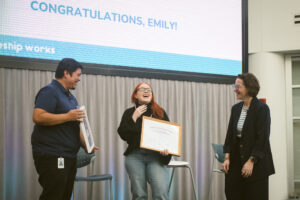Jason Hill, Papercut Interactive
Do any of you feel like you woke up this morning and were suddenly the lead character in a sci-fi movie? I did. I’m working from home, my kids are home, my wife is home, and oh yeah, we’re fostering two dogs for the next two(ish) weeks. Actually, we’re not really sure how long we’ll be “socially distant,” communicating through digital tools and social media more than face-to-face. These are uncertain times. COVID-19 has undoubtedly changed our world. But, we’ve seen change before … and we got through it.
My company, Papercut Interactive, has been in business since 2001. Many of you who have been in business that long also remember well how the world paused for a bit on 9/11 and the days after. We also saw neighbors coming together, and there was a renewed sense of pride in being an American. During the financial crisis of 2007 and 2008, many businesses took a hit. Some changed drastically and some came back better than before.
The time we’re in now is tough. Some businesses will be able to adapt better to a more digital and remote environment. Some may want to think through other potential revenue streams or other ways of interacting with customers and clients. Here’s how we’ve started to embrace a less-than-traditional working environment.
Adapting to change with digital tools
Over the past few years, the trend in our industry has been to move to a more flexible and often remote workplace. A few months ago we implemented a work-from-home arrangement on Mondays and Fridays. We’ve always used online project management software, but a year ago we switched to Monday.com. With Monday.com, we can customize “Boards” to include tasks that need to be completed for our clients. All tasks are visible to the team, and if a team member has time and the ability to help, she can take ownership of that task. To me the most important part of working together remotely is being in good communication with each other and being able to see easily how we might help each other out.
We’ve also implemented Zoom for video chats and conference calls. We use it with clients for meetings when they are in a different city and the meeting doesn’t need to be in person. We also use Zoom internally for a quick huddle meeting or collaborating on a problem we’re trying to solve for a client.
Admittedly, our company is much easier to adapt to a digital enhancement, particularly when it’s necessary for the health of the globe. I’m impressed by how others have seen a move to more digital options in industries that are not often thought of as digitally savvy.
How others are adapting to a digital world
Some businesses naturally have more affinity with a digital operating model than others, and some have meaningful portions of their businesses already operating in the digital space. Many restaurants, for example, have already embraced the use of apps and online ordering. Chick-fil-A, Starbucks and others allow customers to order from their app and pick it up, without having to endure lines that wrap around the building. Uber Eats and other food delivery services have made it possible to get the food you want (not just pizza) delivered to your doorstep. These conveniences are simple enhancements that embrace the digital world and offer safer alternatives to onsite dining in the current environment.
Some states are closing all non-essential services — including restaurants — for at least several weeks to contain the spread of the virus. In those circumstances, leveraging that digital presence will be a means of survival for a take-out only world.
A few years ago, Borders did not see the need to change from an onsite to an online bookseller; in fact, they viewed the onsite experience as being a key differentiator to the rise of Amazon. That approach cost them dearly as their competitors took ownership of that market. Now, ironically, Amazon is working to create a more robust bricks-and-mortar experience to complement their online dominance. The lesson? It’s always important to have multiple avenues of customer engagement. That lesson is more important in a COVID-19 world than ever before.
What about the businesses that by definition are in-person businesses? What about dentists? What about tourist attractions? What about gyms or theatres? Some will suffer more than others in the world of more social distancing, but there are still ways to stay engaged with customers and be better prepared for the post-virus world.
So I have some downtime and excess capacity … what now?
For some of those in-person businesses, the proprietors may suddenly find that they have more time on their hands for the next few weeks. Here are some action steps they should consider:
- Walk in the shoes of your customers. People are scared. They are receiving conflicting messages about the importance of staying home and altering long-standing routines. As business owners, we need to understand that perspective and incorporate true empathy into our messaging and business decisions. Customers will remember after the crisis has passed how you handled it.
- Be well prepared for the coming snapback. Pent-up demand is like a coiled spring: when the virus crisis diminishes, people will want to be out and about more than ever before. A thoughtful business will be planning now to take advantage of the change, building its web and social presence, finding new ways to connect with customers and broadening its reach.
- Think about more substantive change. So this crisis will pass. How will you have used this time to strengthen your core business prior to the next existential threat? What can we do to create multiple paths of customer engagement and new means of customer interaction and satisfaction?
Questions I’m asking to prepare for what “normal” looks like later this year
Some businesses, like ours, are much more suited to making a quick change if needed. Others can use this opportunity to extend their reach for the future. The key will be to use all of our resources well now in preparation for the strong snapback economy coming in the fall. So I find myself asking a few simple questions in the meantime. First, what can I do to make my own business stronger during this challenging period while taking care of my employees and the clients who are counting on me? Second, how can I be helpful to other businesses that are struggling through a difficult period of depressed traffic and low cash flows for the foreseeable future? Let’s face it: as business owners, we’ve all been there from time to time. And there’s one thing I can say about Americans in general and about small business owners in particular: we’re at our best in times of crisis and when we’re reaching out to help each other. Now is the time to be at our best.
Stay safe, and use this time to build your business for the future.






